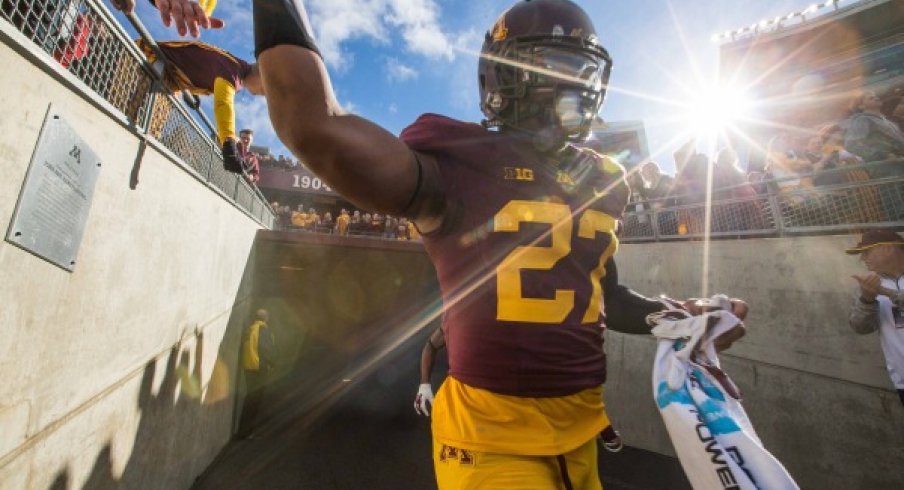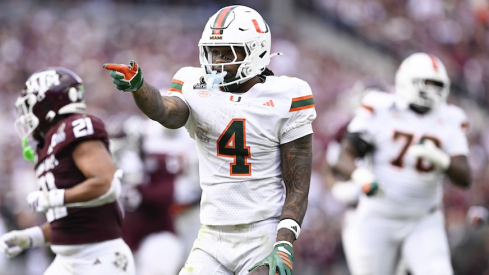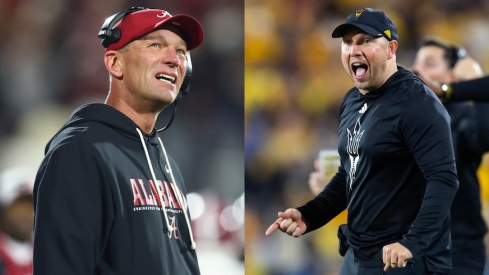For those of you that long for the classic, downhill running games that long defined the Big Ten, this week is your dream come true.
The Minnesota Golden Gophers are a throwback in this era of spread-out, fast-paced offenses. With an offense built completely around bell-cow tailback David Cobb, Jerry Kill's team has shocked nearly everyone with their 7-2 effort this fall.
Until their loss at the hands of Illinois two weeks ago, the only blemish on their record came at the (newly respectable) hands of TCU on the road in Fort Worth. But the loss to the Illini may have begun to show cracks in the foundation of a team that had yet to hit their most difficult part of the season.
The Gophers play their final home game in a cold TCF stadium on Saturday against Ohio State, but will be tested twice more on the road against Nebraska and Wisconsin to finish out the campaign. Although they rank near the top of the conference in a number of categories statistically, their biggest win of the year may have been to one of the worst teams to come out of Ann Arbor in quite some time. Coming off a convincing 51-14 win over an Iowa team that came in at 6-2 though, Minnesota appears to be back on track and ready for this much rougher stretch of the schedule.
Although Urban Meyer noted yesterday that Minnesota is among the league leaders in a number of categories, they clearly over-index in their ability to run the ball while struggling to throw it. However, stopping Cobb and the Gophers will be much more difficult than it sounds.
Offense
Much in the same way Northwestern jolted the conference with their "spread" offense in the late 90's and early 2000's, Minnesota throws a completely different scheme at teams than what they're used to seeing. The Gophers are seeing the same advantages that many spread teams gained by using different formations and personnel, but this time it's for the team that uses two running backs and two tight ends most of the time.
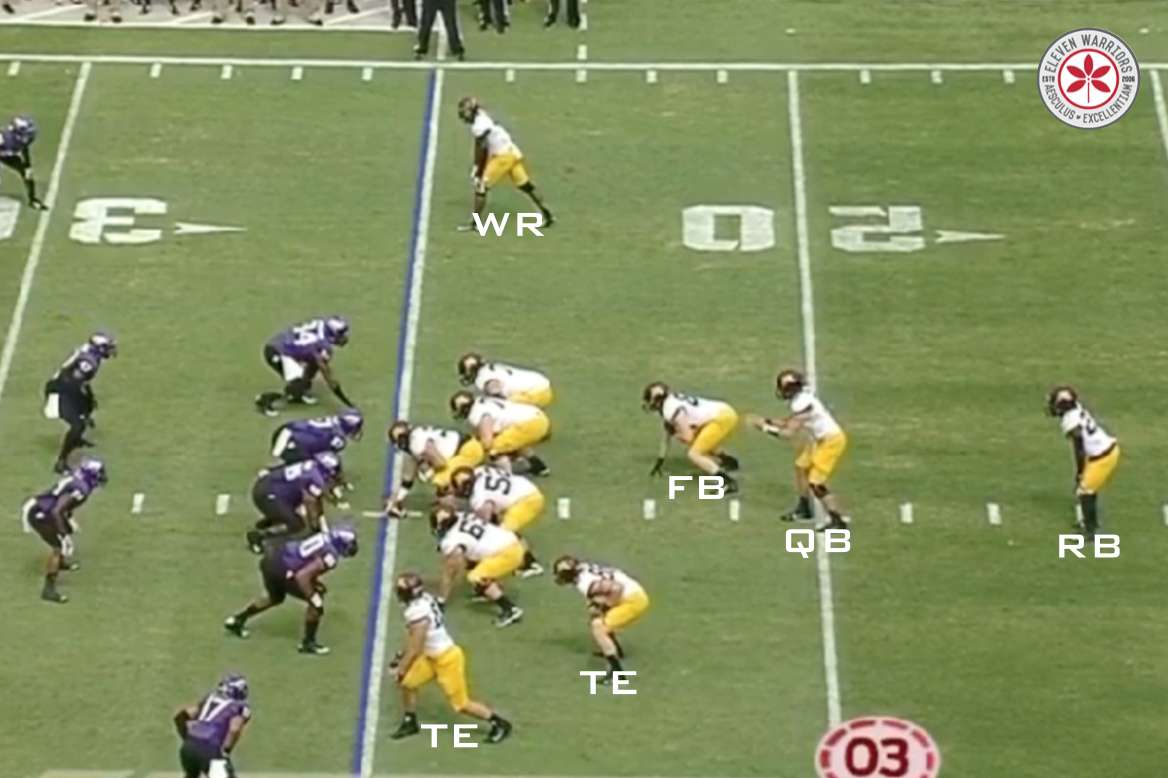
Although many people assume Kill will call for his team to simply run out of the I-formation with a tight end on either side from that personnel group, they do an excellent job of using the pistol, shotgun, and I-formations, as well as using motion from tight end Maxx Williams and fullback Miles Thomas to set up different blocking angles.
These blocks are intended first and foremost to create holes for Cobb, who has carried the ball 227 times already this season, the highest total for anyone in the "Power 5" conferences. But there's good reason for Cobb to keep getting the ball, as he's racked up over 1,200 yards already, while averaging an excellent 5.31 yards-per-carry.
From both the Pistol or I-formation, the Gophers like to get Cobb going with their version of the traditional "Power-O" play, featuring the linemen and fullback blocking the gaps to the inside while the backside guards pulls to kick out the defensive end. Finally, the backside tight end pulls across the formation to seal the hole and lead the way for the back.
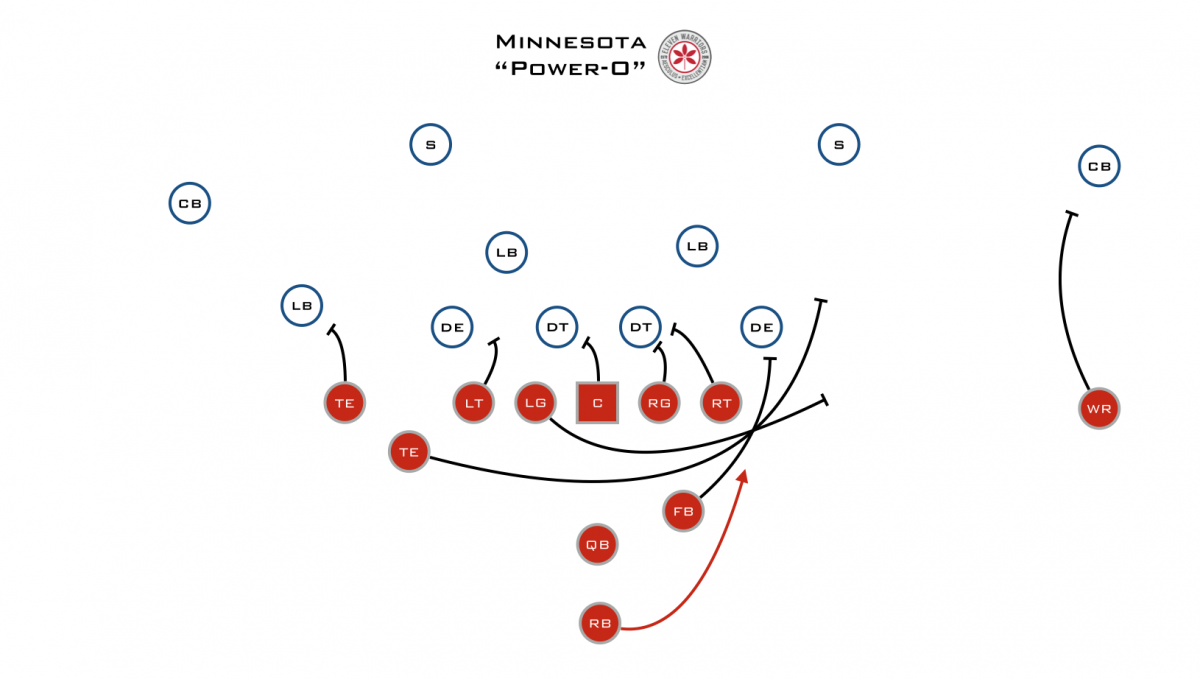
But the Gophers don't just run gap-blocking schemes that come from old I-formation playbooks. Quarterback Mitch Leidner spends quite a bit of time in the pistol or shotgun in order to incorporate read-options off of zone blocking.
Although Cobb is listed at 220 lbs, Leidner tends to be the Gophers' short yardage back of choice. At 6'4" and 237 lbs, the redshirt-sophomore isn't afraid to put his head down and try to run over a linebacker or defensive back.
Leidner is by no means a burner though, and won't beat any defenders around the edge. To help him, the fullbacks or one of the tight ends will often act as a lead blocker, even on option plays.

Using this "split" zone-read was often used by the Buckeyes to open up lanes for JT Barrett against Michigan State, as Ross pointed out.
When looking to get to the outside, the Gophers like to use receiver KJ Maye (#1) as the favored ball-carrier, running jet-sweeps off pre-snap motion. To keep defenses from over-playing the motion, the Gophers often combine the motion with a fake handoff to Cobb, as well as vice-versa to help keep defensive backs from crashing down on the inside running game.
As one would expect from such a diverse and successful rushing attack, the Gophers have an enormous and experienced offensive line. Anchored by seniors Tommy Olson at center and Zac Epping at left guard, the Minnesota offense is able to execute a number of very different concepts, and it wouldn't be surprising to see a new wrinkle added for the Buckeyes.
But although the Gophers have had a great deal of success on the ground, they've struggled to move the ball through the air. Even though they have attempted far fewer passes than any other team in the Big Ten, they've completed the lowest percentage of passes at just over 51 percent.
Much of this comes from the fact that the entire base passing game is effectively just play-action off the base running game. Tight end Maxx Williams is Leidner's top target, catching 22 passes so far, often coming out of the backfield off the same route he'd take to block on the "Power-O" run concept.
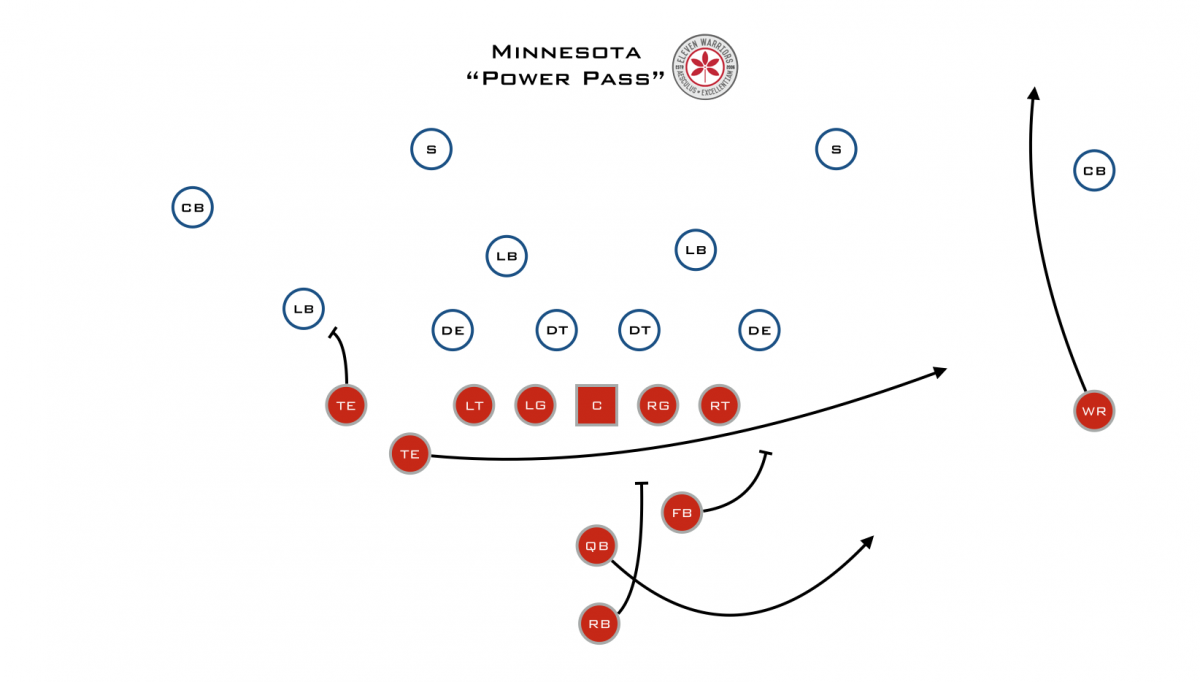
Leidner often rolls out to avoid pressure, and has two options: a receiver on a deep route and Williams coming horizontally underneath. Rolling to either side appears to be where Leidner is most comfortable, making an easy deep-to-short read or tucking to run.
But when sitting in the pocket, Leidner has really struggled. Often doing so only in third-and-medium or long situations, the Gopher signal-caller has thrown five of his seven interceptions from traditional drop-backs and only completing a pass 40 percent of the time.
Part of Leidner's inaccuracy is due to the line's inability to protect against speed rushers. TCU's athletic defense teed off on the Gophers, forcing Leidner to get rid of the ball before he was ready, leading to three interceptions.
For the Buckeyes to shut down the Gopher attack, the linebacker quartet of Josh Perry, Curtis Grant, Raekwon McMillan, and Darron Lee will have to play an extremely disciplined and physical game. The Gophers will try to open holes with seven or eight blockers, meaning this group will often be taking on 300+ lb linemen on their own.
Grant has struggled to get off blocks in the past while McMillan and Lee don't have much experience taking on that much size for an entire game. Safeties Vonn Bell and Tyvis Powell will also likely be called upon to come up and make stops, an area where Powell has struggled with taking proper angles toward the ball carrier.
The interior defensive line, led by Michael Bennett and Adolphus Washington, will have to come up in ways that won't show up in the box score, occupying double teams to keep the linebackers free. But taking on double teams all day is tiring, and their backups must step up, something Meyer has repeatedly spoken about publicly.
The Gophers will undoubtedly pick up yards on the ground, but the Buckeyes must keep them from third-and-short situations. Forcing Leidner to make plays instead of Cobb is a much more favorable scenario for Ohio State, and ultimately on that could shape the outcome of the game.
Defense
While their offense may appear to be quite conservative, the Gopher defense is quite the opposite. With good athletes in the secondary, Kill asks a lot of those defensive backs, putting them regularly in man coverage to allow the front seven defenders to make plays in the backfield.
Led by juniors Eric Murray (#31) at right cornerback and Antonio Johnson (#11) at free safety, the back end of the Minnesota defense has made plays all year long, putting the unit in the top quarter of every major defensive statistic nationally. The group has also done an excellent job of forcing turnovers, intercepting 12 passes so far.
Kill and longtime defensive coordinator Tracy Claeys mix up the coverage schemes, and have clearly done an excellent job of coaching up the specific techniques required by each. Appearing to favor Cover 0, Cover 1, and the Inverted Cover 2 defense that gave OSU so many problems against Virginia Tech, the Gopher cornerbacks have a boatload of responsibility on their shoulders every single play.
Against more traditional teams like Iowa, this approach has netted extremely positive returns, allowing Murray and the other corners to take away the outside while Johnson, a Shaker Heights native, comes up to make plays in run support. But against TCU, the spread formations and hurry-up pace of the Horned Frogs gave the visitors from Minneapolis all kinds of trouble.
Looking to keep the safety in a deep zone to read the eyes of the QB, the remaining Gopher back seven is now in man coverage. While they bring in a nickleback to help cover the extra receivers on the field, that occasionally meant one of their big, inside linebackers would have to walk out and cover a slot receiver in man coverage when TCU went with five-wide packages.
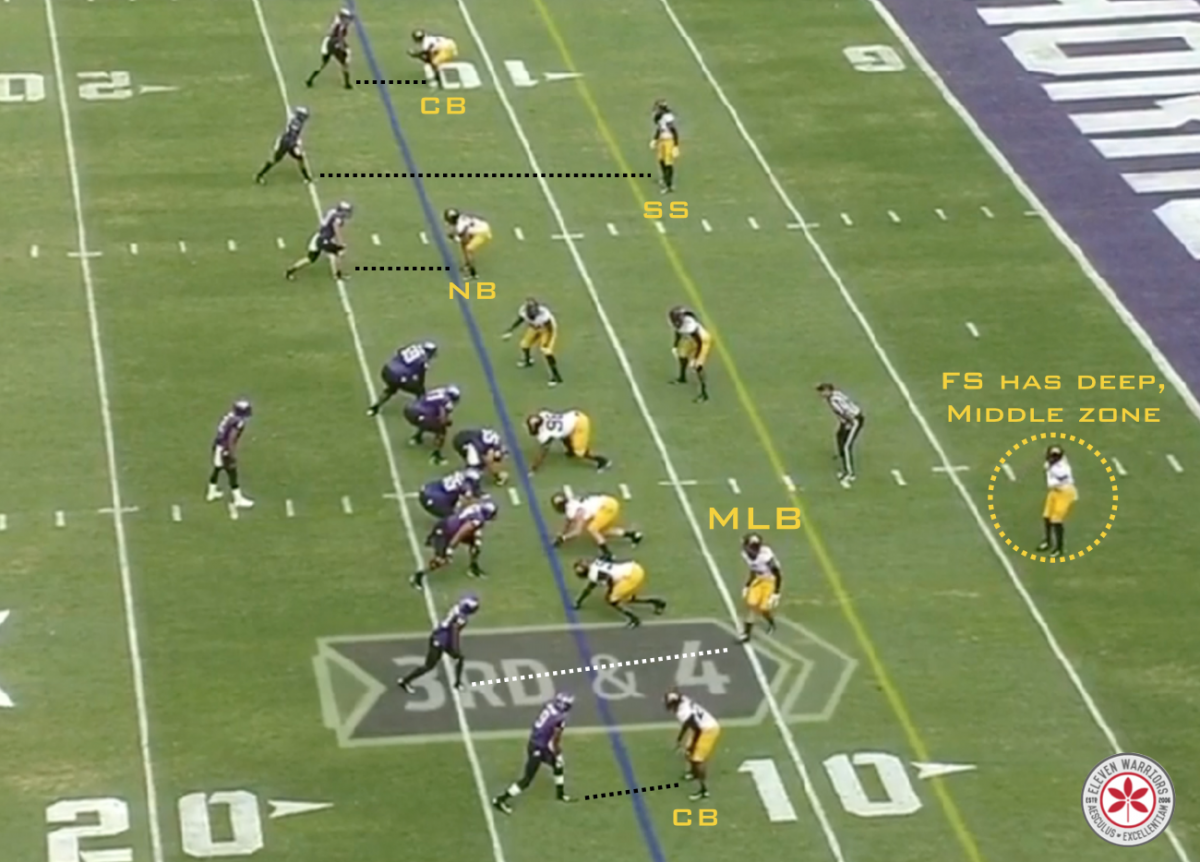
Not only do these spread formations stress their personnel, they also give cushions to slot receivers. To avoid getting picked on "switch" routes off the line, defenders covering the inside receivers play far off, a tactic that opens up quick screens to these players.
But the Buckeyes should also be able to use these spread looks to run the football. The Gopher run defense is anchored by middle linebacker Damien Wilson (#5), who leads the team by far in tackles, and also happens to be the cousin of star tailback, Cobb. Wilson is an excellent tackler who doesn't shy away from contact, so OSU must be able to get blockers to the second level, keeping him from running around to make plays. One such way would be for the Buckeyes to use one-back Power out of these spread looks, something they did well against Michigan State.
All in all though, the Buckeyes should look to establish the run early and often against Minnesota's 4-3 Over front. Although Meyer praised them recently, the Gopher defensive line has made relatively few plays in the backfield this year, with many of those coming against Illinois, San Jose State, and Middle Tennessee State.
The group has had an even more difficult time getting pressure on the quarterback, with team leader Cameron Botticelli (#46) mustering only three thus far. To create pressure, the Gophers like to bring pressure from those excellent defensive backs, gambling that they won't get beat in single coverage.
One of their favorite such concepts is the boundary corner blitz, specifically bringing Murray off his right cornerback spot and letting the safety to that side pick up his receiver in man coverage.
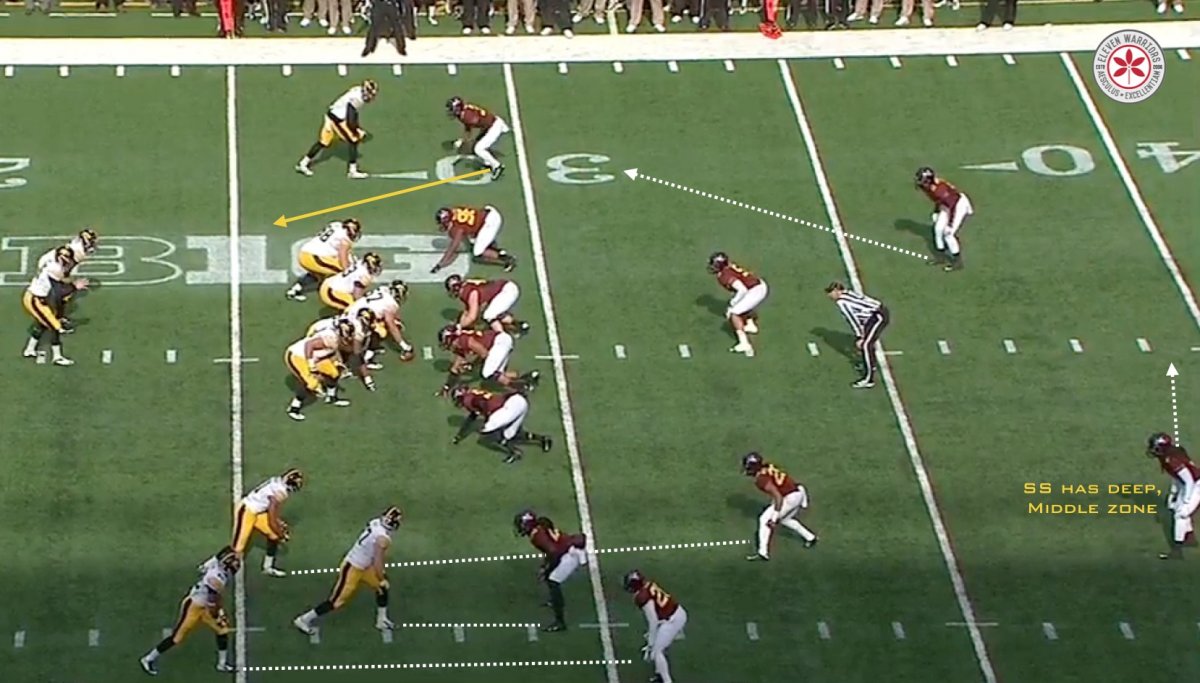
Considering how effective the Buckeyes were offensively during their most recent outing in East Lansing, it's fair to expect the trend to continue in the north star state. The Gophers will likely try to execute the same strategy that worked so well for Virginia Tech, bringing their safeties into the box to stop the run and relying on their corners to prevent any deep passes.
But after seeing what JT Barret and the Buckeye offense did to an even better Spartan defense, OSU still holds a big advantage. Knowing the Gopher offense isn't built to come from behind, one can expect the Buckeyes to attack quickly, looking to get out in front and end any hope of an upset early.
